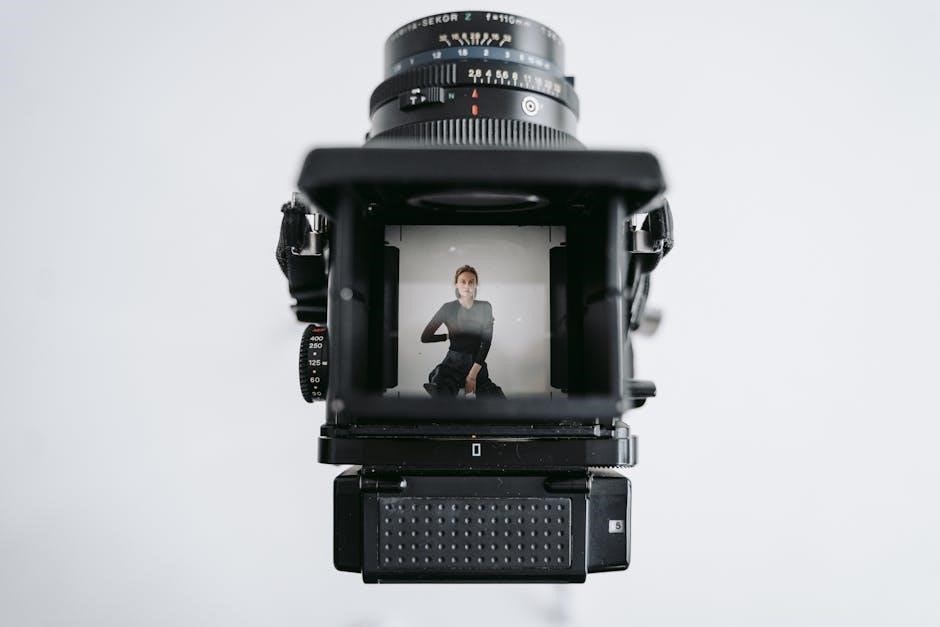Walter Benjamin’s seminal essay explores how mechanical reproduction transforms art’s role, challenging traditional notions of originality and aura in the modern era.
1.1 Historical Context of Walter Benjamin’s Essay
Written in 1936, Walter Benjamin’s essay reflects the societal shifts of the early 20th century, marked by the rise of fascism and technological advancements. Photography and film were transforming how art was consumed, leading Benjamin to explore the loss of aura and art’s commodification. The essay captures the tension between traditional art forms and the emerging culture of mechanical reproduction, offering a critical perspective on modernity’s impact on artistic value and authenticity.
1.2 Key Concepts: Aura, Mechanical Reproduction, and Art
Benjamin introduces the concept of “aura,” the unique, otherworldly quality of an original artwork. Mechanical reproduction, through technologies like photography and film, erodes this aura by enabling mass distribution. Art, traditionally tied to ritual and authenticity, becomes democratized yet loses its singular presence. These concepts form the essay’s core, exploring how reproduction reshapes art’s cultural and political significance in the modern age.

1.3 Relevance in Contemporary Art and Cultural Studies
Benjamin’s essay remains a foundational text in contemporary art and cultural studies, offering insights into the digital age. His ideas on mechanical reproduction resonate with today’s digital art, where reproduction is instantaneous and ubiquitous. The essay’s exploration of aura, authenticity, and mass production continues to influence discussions on art’s role in a hyper-reproducible world, making it a vital framework for understanding the intersection of technology and creativity.
The Concept of Aura in Art
The aura refers to the unique, intangible essence of an original artwork, embodying its historical and spatial authenticity, which fades with mechanical reproduction.
2.1 Definition and Significance of Aura
Aura, as defined by Walter Benjamin, is the unique, intangible essence of an original artwork, rooted in its historical and spatial presence. It embodies the authenticity and emotional connection that arises from the artwork’s physical existence. The significance of aura lies in its ability to evoke a profound, almost mystical, engagement between the viewer and the artwork. However, Benjamin argues that mechanical reproduction erodes this aura by creating multiple, identical copies that lack the original’s singular presence and historical context.
2.2 The Decline of Aura in the Age of Mechanical Reproduction
Benjamin argues that mechanical reproduction erodes the aura of artworks by detaching them from their unique historical and spatial contexts. Reproduction enables mass distribution, making art more accessible but diminishing its mystical and ritualistic significance. The loss of aura transforms art from an object of reverence to a commodity, shifting its function from ritual to exhibition. This decline reflects the broader cultural shift toward democratization and secularization of art in modern society.
2.3 Aura in Contemporary Art Practices
Despite Benjamin’s prognosis, contemporary art practices have reinterpreted aura in new forms. Digital art, immersive installations, and virtual reality create experiential authenticity, reviving the aura concept. Artists explore ways to reintroduce uniqueness through interactive and ephemeral works, challenging mechanical reproduction’s homogenizing effects. This resurgence highlights the adaptability of aura, as modern technologies enable new modes of presence and engagement, redefining its role in the digital age.

Mechanical Reproduction and Its Impact on Art
Benjamin’s essay highlights mechanical reproduction’s transformative impact, democratizing art by making it accessible beyond elites. This shift alters art’s function in society, from ritual to mass consumption.
3.1 The Role of Technology in Democratizing Art
Technological advancements in mechanical reproduction dismantled art’s exclusivity, making it accessible to the masses. Benjamin argued that this democratization broke the aura’s spell, allowing art to reach diverse audiences and challenge traditional hierarchies. Photography and film exemplified this shift, enabling widespread dissemination and fostering new forms of engagement. This transformation redefined art’s cultural and political potential in the modern era.
3.2 The Shift from Unique to Reproducible Art
Benjamin highlights how mechanical reproduction erodes the uniqueness of art, stripping it of its aura. The original, once sacred and irreproducible, becomes a mere template for mass replication. This shift fundamentally alters perceptions of authenticity and value. Photography and film, as prime examples, demonstrate how reproduction detaches art from its ritualistic origins, rendering it accessible yet devoid of the singular, tangible essence that once defined it.
3.3 The Democratization of Art and Its Challenges
Benjamin argues that mechanical reproduction democratizes art by making it accessible to the masses. However, this accessibility comes at a cost, as the aura of the original artwork diminishes. The proliferation of reproductions challenges traditional notions of artistic authority and authenticity. While reproduction broadens art’s reach, it also risks homogenizing cultural experiences and reducing art to a commodity, creating tension between accessibility and the preservation of art’s unique, ritualistic value.
The Transformation of Art’s Function in Society
Benjamin examines how art transitions from ritualistic purposes to public exhibition, evolving into a political tool in the modern era, reflecting societal changes and ideological influences.
4.1 From Ritual to Exhibition: The Changing Role of Art
Benjamin discusses how art transitions from sacred rituals to public exhibitions, losing its mystical aura. Mechanical reproduction enables mass distribution, democratizing art and shifting its cultural significance. This transformation recontextualizes art, moving it from intimate, sacred spaces to broader, secular audiences, altering its function and meaning in society.
4.2 Art as a Political Tool in the Modern Era
Benjamin highlights how art becomes a powerful political tool in the age of mechanical reproduction. Mass-produced images and art can spread ideologies widely, influencing public consciousness. This democratization of art enables political movements to leverage its emotional impact, creating a dual potential for empowerment or manipulation. The essay underscores the tension between art’s revolutionary possibilities and its co-option by propagandistic forces in modern society.
4.3 The Commodification of Art in the Age of Reproduction
Benjamin’s essay explores how mechanical reproduction transforms art into a commodity, shifting its value from unique aura to market-driven worth. The art market thrives by capitalizing on accessible reproductions, altering the artist’s role and perception of art as a commodity. While democratizing access, this commodification risks reducing art’s deeper cultural significance to its commercial appeal, impacting both creators and consumers in the process universally.

The Role of the Viewer in the Age of Mechanical Reproduction

Mechanical reproduction empowers viewers by democratizing art access, fostering personal engagement, and shifting perception from sacred to secular, emphasizing individual interpretation.
5.1 The Democratization of Art Consumption
Mechanical reproduction dismantles art’s exclusivity, making it accessible to masses. Photography and film enable widespread dissemination, breaking barriers of geography and class. This shift transforms art from a sacred, ritualistic experience to a secular, everyday encounter. Viewers gain agency, engaging with art in personal spaces, fostering diverse interpretations. Democratization challenges traditional hierarchies, democratizing cultural participation and redefining art’s social role. This accessibility sparks new dynamics in how art is perceived and consumed;
5.2 The Role of the Viewer in Shaping Art’s Meaning
Mechanical reproduction empowers viewers to interpret art personally, detached from its original context. Benjamin argues that reproductions enable collective engagement, shifting art from ritual to everyday experience. Viewers’ diverse perspectives reshape meanings, democratizing interpretation. This transformation reflects art’s evolving function in society, where individual and shared experiences redefine its significance. The viewer’s role becomes active, fostering a dynamic interplay between art and its audience. This shift underscores the loss of aura yet gains in accessibility and reinterpretation.
5.3 The Viewer’s Experience in the Digital Age
The digital age amplifies Benjamin’s ideas, as reproductions circulate widely online. Viewers engage with art through screens, fostering new forms of interaction and interpretation. Digital platforms enable instant access, creating a global audience. However, this accessibility often diminishes the artwork’s physical presence, or aura. Yet, it also democratizes art consumption, allowing viewers to reinterpret and share works, blurring the line between passive observation and active participation in shaping cultural meaning.
The Impact of Mechanical Reproduction on Traditional Art Forms
Mechanical reproduction challenges traditional art’s authority, enabling new movements while eroding the aura of originals. It integrates reproduction into contemporary practices, reshaping artistic expression and cultural engagement.
6.1 The Erosion of Traditional Artistic Authority
Mechanical reproduction undermines the uniqueness of traditional art, challenging its authority. Walter Benjamin noted that reproduction erodes the “aura” of originals, democratizing art and reducing the artist’s mystical status. As reproductions proliferate, the original’s presence in time and space becomes less significant, shifting art’s function from ritual to broader, political, and cultural uses. This democratization of consumption diminishes the exclusive authority of traditional artistic forms and institutions, reshaping cultural engagement and artistic expression.
6.2 The Emergence of New Artistic Movements
Mechanical reproduction fostered new artistic movements by enabling mass dissemination of images and ideas. Movements like Dadaism and Surrealism thrived as reproduction allowed experimentation with new forms and audiences. The accessibility of reproduced art democratized creative processes, inspiring fresh perspectives and challenging traditional norms. This shift not only expanded artistic expression but also encouraged collaboration and innovation, reshaping the cultural landscape and fostering a dynamic exchange between artists and their audiences globally.
6.3 The Integration of Reproduction in Contemporary Art
Contemporary art increasingly embraces mechanical reproduction, integrating it as a fundamental aspect of creative practice. Digital tools enable artists to produce and disseminate works globally, challenging traditional notions of originality. Reproduction has become a norm, fostering new forms like digital installations and AI-generated art. This integration democratizes art, making it more accessible while encouraging innovative approaches that blur the lines between original and copy, redefining artistic expression in the digital age.

The Political and Social Implications of Mechanical Reproduction
Benjamin’s essay highlights how mechanical reproduction reshapes power dynamics, enabling art to serve political agendas while democratizing access, thus influencing societal perceptions and cultural narratives significantly.
7.1 Art as a Tool for Political Propaganda
Benjamin argues that mechanical reproduction enables art to become a powerful tool for political propaganda, as it allows mass distribution and manipulation of images. This phenomenon, rooted in the reproducibility of art, facilitates the dissemination of ideological messages to a broader audience. While democratizing art, it also risks reducing it to a medium for political control, highlighting the tension between accessibility and ideological manipulation in the modern age.
7.2 The Role of Art in Shaping Cultural Identity
Art, in the age of mechanical reproduction, plays a pivotal role in shaping cultural identity by making artworks widely accessible. This accessibility fosters a shared cultural experience, allowing diverse audiences to connect with artistic expressions. However, reproduction also risks homogenizing unique cultural elements. Benjamin highlights how this tension between universality and specificity influences cultural identity, balancing the preservation of heritage with the dynamic evolution of artistic traditions in a globalized world.
7.3 The Tension Between Art and Mass Culture
Benjamin’s essay underscores the tension between art and mass culture, where mechanical reproduction democratizes access but risks reducing art to commodity. While mass culture broadens art’s reach, it often dilutes its critical potential. This tension reflects the struggle between preserving art’s aura and embracing its proliferating forms in modern society, highlighting the complex interplay between authenticity and accessibility in the age of mechanical reproduction.

The Legacy of Benjamin’s Essay in Modern Times
Benjamin’s essay remains foundational in contemporary art theory, influencing digital art and cultural studies. Its relevance endures as technology evolves, shaping discussions on reproduction, authenticity, and art’s societal role.

8.1 The Relevance of Benjamin’s Ideas Today
Benjamin’s concepts of aura and mechanical reproduction remain highly relevant in the digital age. His exploration of how technology alters art’s meaning and accessibility continues to resonate. The rise of digital art, social media, and mass reproduction has intensified the debate over authenticity and cultural value. Benjamin’s ideas provide a critical framework for understanding these shifts, making his essay a cornerstone of contemporary art and cultural theory.
8.2 The Influence on Contemporary Art Theory
Benjamin’s essay has profoundly shaped contemporary art theory by highlighting the interplay between technology, authenticity, and cultural value. His concepts of aura and mechanical reproduction are central to discussions on digital art, mass media, and reproduction’s democratizing effects. Scholars and critics use his framework to analyze how art’s meaning evolves in the digital age, influencing debates on originality, accessibility, and the role of technology in shaping artistic expression and cultural consumption.
8.3 The Application of Benjamin’s Concepts in Digital Art
Benjamin’s ideas resonate in digital art, where mechanical reproduction is instantaneous and global. Digital platforms enable mass dissemination, challenging traditional notions of originality and aura. Artists use algorithms and virtual galleries to explore new forms of artistic expression. Benjamin’s concepts help analyze how digital art democratizes access while redefining the relationship between the viewer, the artwork, and its cultural value in the age of digital reproduction.
Benjamin’s essay remains pivotal in understanding art’s transformation through mechanical reproduction, emphasizing the loss of aura and the democratic access to art, influencing contemporary digital practices and cultural discourse.
9.1 Summary of Key Arguments
Benjamin’s essay argues that mechanical reproduction diminishes the aura of art, transforming its cultural and ritual value into political and mass-consumable forms. He explores how technology democratizes art, shifting its function from sacred to profane, and enabling new modes of perception and appropriation. The loss of aura, he contends, challenges traditional notions of originality and authenticity, while also opening possibilities for art’s political engagement and widespread accessibility in modern society.
9.2 The Enduring Importance of Benjamin’s Work
Benjamin’s analysis remains pivotal in understanding art’s evolution in the digital age. His concepts of aura and mechanical reproduction continue to influence contemporary debates on originality, authenticity, and mass culture. The essay’s relevance spans art theory, cultural studies, and media theory, offering insights into how technology reshapes artistic value and consumer engagement. Its timeless themes ensure Benjamin’s work remains a cornerstone for scholars and theorists examining the intersection of art and technology.
9.3 The Future of Art in the Age of Digital Reproduction
Digital reproduction continues to transform art, pushing boundaries of accessibility and creativity. As technology advances, the concept of aura evolves, with digital art challenging traditional notions of originality. The democratization of art through digital platforms democratizes consumption, enabling global engagement. Benjamin’s ideas remain central to understanding this shift, as art adapts to new mediums, raising questions about authenticity and cultural value in an increasingly virtual world.
References and Further Reading
- Benjamin, W. (1969). Illuminations: Essays and Reflections. New York: Schocken Books.
- Aliev, R.T. (2025). The Work of Art in the Age of Mechanical Reproduction. London: Routledge.
- Durham, M.G., & Kellner, D.M. (2006). Media and Cultural Studies. Malden: Blackwell Publishing.
- Sandomirskaja, I. (2000). Ueber die Sprache. Berlin: De Gruyter.
10.1 Key Texts by Walter Benjamin

Walter Benjamin’s essay, The Work of Art in the Age of Mechanical Reproduction, is a foundational text in cultural theory. First published in 1936, it explores the impact of technology on art’s aura and authenticity. The essay is included in his collection Illuminations: Essays and Reflections, translated by Harry Zohn. Another key text is Understanding Brecht, which examines the intersection of art and politics. These works remain central to studies of modern art and media.
10.2 Contemporary Scholarship on Mechanical Reproduction
Contemporary scholars like Durham and Kellner expand on Benjamin’s ideas, analyzing their relevance in digital media. Researchers such as Sandomirskaja explore the intersection of technology and cultural identity. Modern studies also address how mechanical reproduction influences art’s commodification and political uses. These works provide fresh perspectives on Benjamin’s theories, adapting them to the digital age and its implications for art and culture.

10.3 Recommended Reading for Advanced Study
For advanced study, key texts include Durham and Kellner’s Media and Cultural Studies, which expands on Benjamin’s theories. Sandomirskaja’s work on cultural identity and technology offers deeper insights. Additionally, Routledge’s A Museum Studies Approach to Heritage provides a modern, interdisciplinary perspective. These works, along with Benjamin’s original essay, form a comprehensive foundation for understanding the evolving impact of mechanical reproduction on art and culture.



